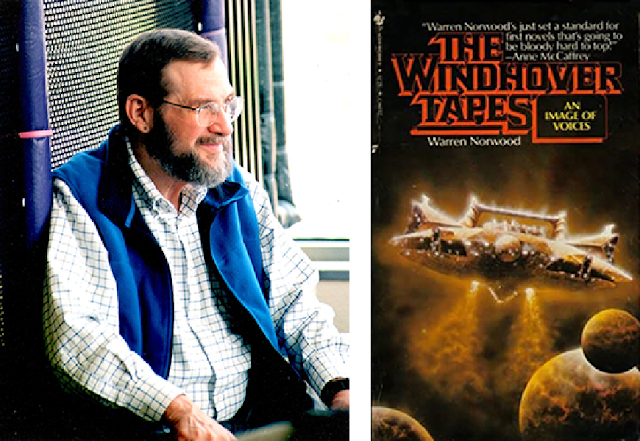Science fiction writers with long careers may be forced to decide about knocking off the zeerust from some of their older works.
Knocking off the zeerust . . . from what?
What is "zeerust"?
We've all seen it--it's what you might call "retro futuristic" ideas, looks, or concepts. It's "zeerusty" if at some point in the past it seemed futuristic, but now it just looks quaint or dated. We can thank Douglas Adams of The Hitchhiker's Guide to the Galaxy (and so much more!), for this word.
 |
| A city scene from the 1927 movie Metropolis. (photo courtesy of CCNY Libraries). |
Another description might be "Raygun Gothic," which refers to the tropes and idiosyncracies found in "Golden Age" pulp science fiction. You know it when you see it. "From about Metropolis till the dawn of Star Trek's original series. For example, the Hugo Award is an example of a classic Retro Rocket.
I did a whole series of posts on this phenomenon back in October 2018, although I didn't know the word "zeerust" at the time. The posts highlighted videos from the 1920s through the 1950s that featured "Futuristic" visions of "Tomorrow" in general, of kitchen technology, of automotive technology, and the kind of houses we might live in.
As the opening line indicates, I was reflecting on writing careers that have lasted long enough for earlier works to have acquired some zeerust. For writers in my age range, their book could date to the 1970s or 1980s. "Knocking off the zeerust" in this case implies a fiction-remaking process not unlike what my husband did last weekend for an old iron patio table, using some emery paper, a wire brush, and a can of Rustoleum.
Knocking off the zeerust . . . from what?
This whole question of zeerust arose because I'm currently reading Lee Killough's 2015 edition of The Doppelgänger Gambit. It's a fresh re-envisioning of her 1979 novel by the same name, published by Ballantine (and well received, at the time).
 |
| The original 1979 cover of The Doppelgänger Gambit reflected the time it was published. The 2015 cover looks much different. Author Lee Killough masterminded the remake. (Photos courtesy of James Nicoll Reviews, Amazon, and Books We Love). |
Early in the 2010s, when I was first thinking about police dogs on a space station, Lee and I had a conversation at one of the many SoonerCons we've both attended. She told me about her research into new, cutting-edge forensics, and a few of the cool things she'd learned.
I'm one of those weird folk who like actual, physical, dead-trees-type books. I've been waiting for her publisher, Books We Love, to come out with a trade paperback, but after five years I figure that's a doomed effort. So I grudgingly caved, and bought the Kindle edition.
Is knocking off the zeerust a good idea?
There's a valid case to be made for leaving "vintage" works as they are. Respecting the author's original vision, and viewing it in its historical context is never wrong. But any number of good reasons do exist for an author to go for a reprint, a revised edition, or even a whole new "remake," as Lee did.
 |
| Some things need no re-imagining. This artwork by Frank Kelly Freas is a dynamic masterwork of its Golden Age Pulp Science Fiction genre. The illustration was created for a story by Leigh Brackett in the September 1953 issue of Planet Stories--12 years before the first spacewalk. (Image courtesy of Scanzen on Tumblr.) |
In Lee's case, she felt it was absolutely necessary--and I have to respect her artistic choice. The updates are fascinating. I read the original version not long after I first became aware of it, back in the early 1980s. And yes, in the intervening years it definitely had accumulated some zeerust. It's "near future" science fiction, set in 2091, and thus perilously prone to that kind of thing.
When the rights reverted, she wanted to re-release it, but couldn't live with the zeerust. Remakes can be a huge risk, but sometimes they're worth it. I haven't finished reading this one, so I can't tell you (yet) if I think it was worth it in this case. Although, so far I'm enjoying myself.
Zeerust and Weird Sisters Publishing
The "zeerust" question is relevant to Weird Sisters Publishing. My sister and I plan to re-release several novels by G.'s late husband, Warren C. Norwood. We also plan to dust off several of the novels she wrote in the 1990s, that didn't quite fit what the romance editors were looking for at the time.
We think all of them are still good books. Sadly, Warren isn't here anymore to defend himself, so his works stand as they are. G. may make some adjustments, but she intends to keep them grounded in the decade when they were written.
 |
| Warren C. Norwood never loved the covers he got--but in 1982 a first-time novelist had no say over the images his publisher chose to slap on his books. In Jan's opinion, the best of the lot was the one at right--a stock cover they'd bought beforehand, based on nothing in the story. We hope to do better when we re-issue his books! (Photos courtesy of G.S. Norwood and Amazon.) |
And yes, I have a couple of novels that date to the 1980s and 1990s, too. Both are science fiction, and both could stand to have a little zeerust brushed off and be touched up. Both came very close to being published "back in the day," but I have no current plans to revisit them.
No, I'd rather stay focused on Rana Station and the XK9s, for now, thanks!
No comments:
Post a Comment